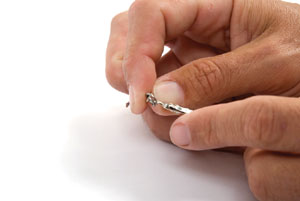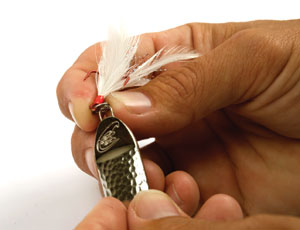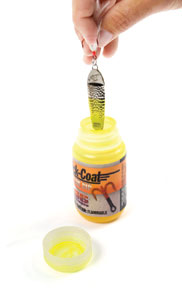
A slab of metal with a treble hook attached … looking at it makes one wonder why bass would find it attractive! Yet during the coldwater period of the year, the jigging spoon receives high marks for drawing hard hits from largemouth, spotted and smallmouth bass.
Of course, fishermen who simply take the spoon right from the package, tie it on, drop it over the side and begin jigging are not going to achieve the same level of success as anglers who tweak both the lure and the presentation. In order to get the most out of coldwater spooning, check out these insider tips of BASS pros from different regions of the country.
TIMING & LOCATION
Down in northern Alabama, Elite pro Tim Horton says water temperature is one key to vertical jigging. “With water temperatures between 37 and 47 degrees, you’ll generally find a good wintertime spoon bite on Southern reservoirs. At these temperatures, baitfish schools are congregated within a specific depth range, usually associated with a steep structure — although on certain lakes the bait will be in the tops of standing timber. I never drop a spoon unless I can see baitfish and some larger arches (on my sonar) that would indicate bass.”
Missouri Elite pro Brian Snowden says his Midwest game plan is similar. “The low 40s to high 30s is as cold as water normally gets in our lakes. That’s when vertical spoon jigging is key to catching bass that are holding around baitfish on main lake points, creek channel ledges or standing timber. Fishing 30- to 60-foot depths is common. First, find the preyfish. Then drop and hop!”
While Horton’s and Snowden’s coldwater spooning efforts are directed primarily at largemouth and spotted bass on reservoirs (along with occasional smallie encounters), the focus on the Great Lakes is solely smallmouth bass. Pro angler Frank Scalish of Ohio explains the coldwater spoon bite on Erie occurs in the late fall and again in the spring when water temperature hovers between the low 50s and mid-40s. During winter months, the lake is ice covered.
SPOON DETAILING
Horton starts with a 3/4-ounce C.C. Spoon. First, he removes the stock heavy-duty hook from each lure and then gets creative. He may paint one spoon white, apply prism tape to another or even dip one into chartreuse dye. Horton installs a No. 4 XCalibur treble hook to each spoon — some get a plain treble, some a feather treble.
“Your spooning box should be like your plastic worm and crankbait box — it must have variety,” explains Horton. “There is going to be a certain color or reflective finish that will trigger fish on a particular day better than any other. I can’t say it’s going to be gold, nickel, white or chartreuse; with a feather or without. It’s the old saying: You’ve got to let the fish tell you what they want. When I plan to spoon all day, I’ll have three or four rods, each rigged with a different spoon finish, and keep rotating through them until I figure out their preference.”
When it comes to re-installing hooks on a C.C. Spoon, Horton’s insider tip is to reverse the line tie and hook. Because the original C.C. Spoon is a bit heavier on the front end, when jigged up and down, the hook tends to swing around and grab the line. Horton realized that by placing the hook/split ring on what was the front of the spoon and attaching the line to the back end of the spoon with a snap swivel, entanglements were reduced.
When jigging standing timber, Horton substitutes a 1/0 drop shot hook for the treble. “I may miss a strike or two over a day’s fishing with a single hook, but it pays off in the long run as a timesaver by reducing hang-ups.”
Snowden acknowledges that every good spoon fisherman tweaks his bait, and he is no different. He begins with 1/2- and 3/4-ounce BPS Strata Spoons in nickel or white paint finish. The stock hook is replaced with a No. 2 Owner treble. A large split ring is installed on the spoon’s nose. Snowden recommends oval-shaped rings for the best action.
Feather trebles play an important role for Snowden. “A feather treble not only serves as an attractor, but it also helps to slow the fall rate of a spoon. This is particularly true on a 1/2-ounce spoon. At times, slowing the drop speed can be the difference between catching a couple of bass and catching a mess of fish.”
But at Table Rock some say two feather trebles are better than one. A guide trick that originated there involves a stinger of sorts. Rather than tying directly to the spoon’s split ring, the line’s tag end is run through the split ring and then tied to a second feather treble.
“This setup really slows the fall and sometimes catches two bass at once!” adds Snowden. “I use white feather trebles that have a little hint of either red or blue tinsel. Red may suggest an injured baitfish, while blue tinsel gives a bluish cast — the color of shad in the winter.”
Scalish enlists two brands of spoons, each with different actions. His go-to bait is a 3/4-ounce C.C. Spoon, backed up by a 3/4-ounce Hopkins.
“The C.C.’s action is more even side-to-side flutter — sort of like a falling piece of paper. The Hopkins has an erratic zigzag fall — more like a lightning bolt,” notes Scalish. “I cannot tell you that one action is consistently better than the other. Bass will have a preference on any given day for a certain fall. That is what you have to determine.”
Scalish attaches a No. 5 Crane swivel to each spoon with a split ring to reduce line twist. He says this also gives the spoon more play on the fall. Like all good spooners, Scalish discards the heavy stock hooks. His replacement choices are No. 2 round bend Gamakatsu or XCalibur trebles. “Round bend trebles button bass best,” he adds.
A portion of Scalish’s spoons receive a custom paint job: a creamy white finish with a big blue eye. He uses nickel and white finishes about equally.
PRESENTATION
“Spoon fishing is not a race to cover ground,” emphasizes Horton. “Once you’ve found the fish with your electronics, you need to stay right on top of them. Stop, re-position the boat so you are directly over the fish, and then drop the spoon.
“There are times that ripping a spoon draws the strike, but most fishermen tend to overwork a jigging spoon. I only move the rod tip 4 to 6 inches, which in turn hops the spoon 2 to 3 feet. Keep in mind that during the winter, bass are lethargic. It’s that barely alive flickering shad or minnow that bass are going to target, not something that is jumping wildly all over the place.”
Snowden stresses the need for anglers to understand and correctly read their graphs. “You’ve got to keep the spoon within the sonar cone so you can see the lure’s exact location in relation to prey and predator. I will free spool the spoon straight down, keeping it in the cone all the way. Then I stop it just short of a shad ball on the screen (or just above treetops) and begin working the lure.”
Compared to Horton and Snowden, Scalish is a ripper. “I use hard rod pumps that cause the spoon to shoot erratically off to the side. I want to get their attention. Close to 99 percent of the strikes occur on the fall, and the drop speed for all 3/4-ounce spoons is about the same.”
It is critical to detect a strike during the spoon’s free fall, which follows each upward rod snap. All three pros utilize the technique referred to as controlled drop. The rod tip is lowered just a hair faster than the spoon is falling. This allows the spoon to fall on a slack line, thereby offering the most attractive action. But the amount of slack is controlled. Anglers pay close attention to the little coil of line as it sinks below the surface. At the first hint of a twitch or jump in the line, the rod moves rapidly upward for a hook set.
“One good sweep is all that is needed,” stresses Scalish. “Set the hook and wind. Never stop to reset the hook — that is a sure way to lose the fish.”
TIM HORTON’S MODIFICATIONS
1. Remove the hook and split ring from the bottom of a C.C. Spoon.

2. Swap the standard treble for a feathered one and reattach the split ring and hook to the top of the bait.

3. Dip the bottom half of the spoon in chartreuse dye, and add a snap swivel to the bottom eye that once held the hook.

4. Now your bait is weighted differently and has more flash.

FAVORITE SPOONING LAKES
One November day, Frank Scalish was headed out on Lake Erie when his sonar screen went black. Thinking it was a malfunction, he stopped to check it. Only then did he realize it was solid baitfish. “I dropped my jigging spoon down and immediately began catching bass. In two hours, we caught 79 smallmouth!”
In addition to Erie, Scalish has enjoyed fantastic spoon fishing on Table Rock, Bull Shoals, Smith Lake (Ala.) and Lake Martin.
It’s no surprise that Missouri’s Brian Snowden’s favorite spooning lakes include Table Rock and Bull Shoals. Rounding out his top five are Arkansas’ Beaver Lake plus California’s Lake Castaic and Pine Flats. Tim Horton’s list includes Lake Wilson, Pickwick and Table Rock.
What makes a good spooning lake? Clear water is generally considered an advantage. But during the coldwater period even slightly off-¬color lakes can provide spoon fishing opportunities. The formula is simple: tightly packed baitfish schools holding in water deeper than 20 feet — maybe as deep as 50 or 60 feet or more. Find the baitfish and you won’t need to go looking for bass; they will already be there!




